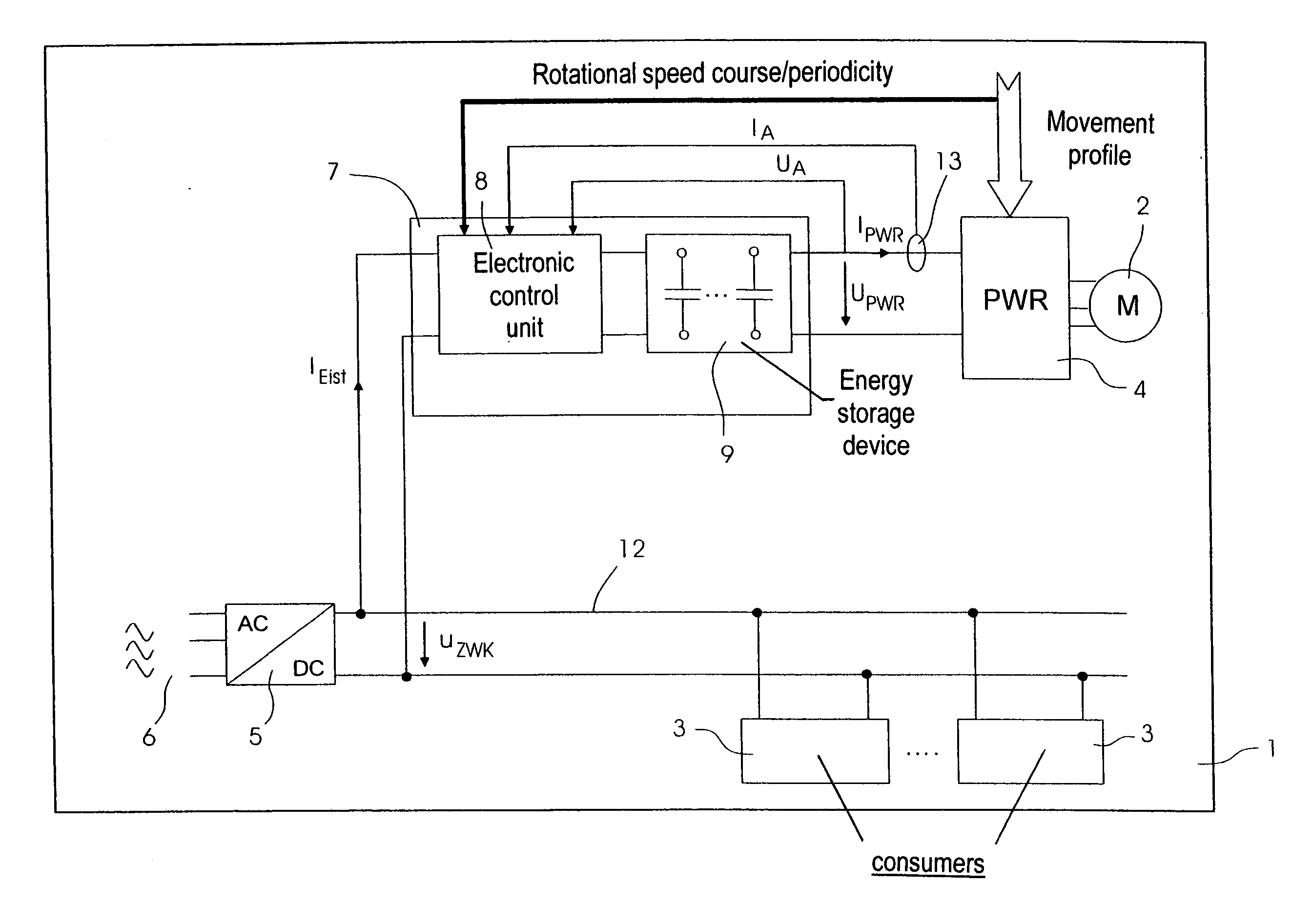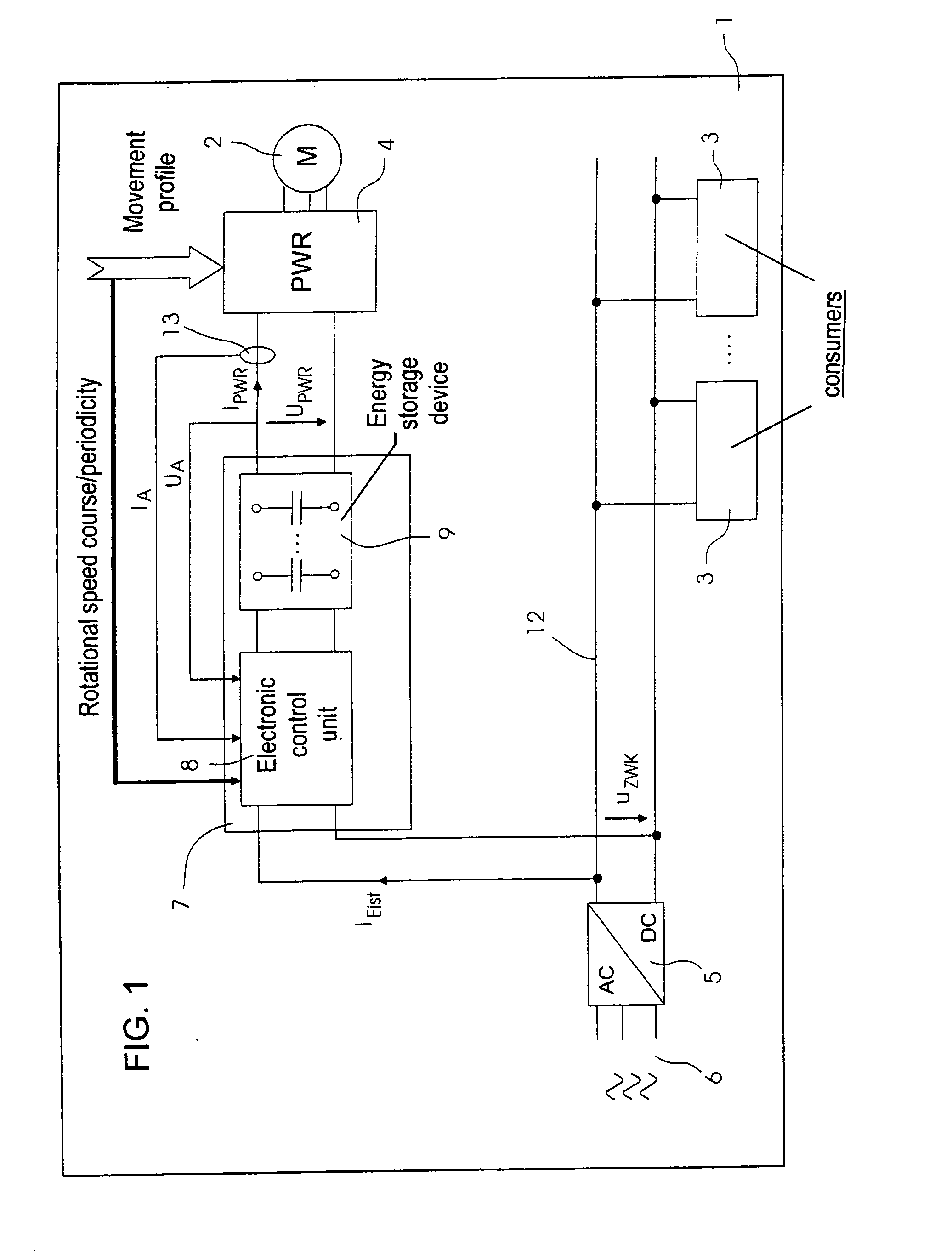[0005]It is accordingly an object of the invention to provide a device for the controlled
power consumption of electric drives in machinery and a machine, including the device, for
processing printing material, which overcome the hereinafore-mentioned disadvantages of the heretofore-known devices and machines of this general type in such a way that power supply devices in machinery may be dimensioned for average
power demand.
[0010]In accordance with a further feature of the invention, the
electric drive is supplied with
electric power through a converter or
inverter. In most cases, printing presses have electric drive motors that are supplied with power through a
voltage controlled in a converter or
inverter. This provides very precise and largely continuous control of the rotational speed of the electric drive motors. The converter converts the direct
voltage present at its input into the alternating
voltage controlled in accordance with the electronic system of the motor. The use of an
inverter is advantageous because it allows not only a current flow from the
DC voltage system to the electric drive, but also, for example during
dynamic braking, a
recovery of the power from the electric drive to the
DC voltage system. In order to keep the loading of the power supply system of the machine as low as possible, the
energy storage device is positioned directly in front or upstream of the converter or inverter of the electric drive. A great
advantage of this is that the peak loads caused by the electric drive only occur in the drive itself and in the converter or inverter, while the total power supply system in front or upstream of the
energy storage device is only loaded with the maximum average
electric power of the electric drive. Due to the positioning of the
energy storage device, the occurring peak loads are locally limited so that the remaining power supply system of the machine can be dimensioned in terms of the average required electrical power taken out of the system. In printing presses, a
direct current intermediate voltage circuit or
DC circuit generally supplies power to a number of electric drive motors. The
power electronics system including the energy storage device, the converter or inverter, and the electric drive are connected to this
direct current intermediate voltage circuit. Due to the device according to the invention, this
direct current intermediate voltage circuit is only loaded with the maximum average demand of the connected electric drive motors.
[0011]Due to a higher-level or superordinate
power electronics system, it is also possible to coordinate the
power demand of the electric drive motors relative to each other to further reduce the maximum required average electric power in the direct current intermediate voltage circuit, for example by avoiding a simultaneous start-up of all of the electric drive motors connected to the direct current intermediate voltage circuit. For this purpose, the
power electronics systems of the motors may communicate with each other either directly or through a computer, e.g. the
machine control unit, to interchange their power calculations for the purpose of coordinating their power requirements. Electric drives of
lower priority then will not be started when the maximum
peak load in the direct current intermediate voltage circuit has been reached. In addition, it is possible to limit the power input of individual drives in order to reduce the total demand. The direct current intermediate voltage circuit may be connected to an AC voltage system through a
rectifier. In printing presses, this connection to the power supply system is the connection of the machine to the 400
Volt three-phase power supply system. Due to the use of the device according to the invention, a relatively uniform power, in particular without any peak loads above the maximum average demand, is taken from the 400
Volt three-phase power supply system.
[0012]In accordance with an added feature of the invention, sensors are provided to determine the current and / or voltage of the motor in order to feed the motor current and / or the motor voltage to the power
electronics system for the purpose of calculating the
electric power demand of the motor. Thus the power
electronics system can take into account actual values of the motor current and actual values of the motor voltage and consequently make adjustments if deviations from the pre-calculated values for the motor current and motor voltage occur. This is done to prevent the motor current and motor voltage from assuming values that would cause the average electric power to increase beyond the predetermined limit. This is an important aspect because even for identical motion profiles, the
electric power demand of drive motors is not constant over their entire useful life. For example, a motor may run more smoothly or become sluggish over time due to wear and may thus require more or less power. In addition, movable components may be blocked, which may increase the power input of the electric drive at least temporarily. All of these aspects can be taken into account due to the determination of the motor current and motor voltage by the power
electronics system. In this manner, the power electronics system may switch off the electric drive, if necessary, or reduce its power input, if compensation for increased power input by the energy storage device is no longer possible. This is another way of preventing the electric drive from exceeding the maximum average power input.
[0013]In accordance with an additional feature of the invention, the power electronics system advantageously includes an
electronic memory for storing motion profiles of the electric drive. Depending on the task of the electric drive in a
printing press, the drive has typical motion profiles. In particular, in the feeder of a
printing press, the electric drives operate in periodic cycles, with the
power demand fluctuating considerably during a cycle. However, this fluctuation can be taken into account by the power electronics system if the motion profile is known. According to the invention, the periodic motion profile in the feeder is stored in a memory location of the power electronics system. As soon as the
printing press is started, based on the machine speed selected by the operator and the stored motion profile, the power electronics system can calculate the required average electric power of the feeder drive motors and charge the energy storage device accordingly. The periodic peak loads occurring in the operation of the feeder will then be compensated for by the energy storage device and will not cause any loading of the direct
current voltage link circuit of the printing press. Thus the invention is particularly suited for
evening out peak loads in periodic motion profiles of an electric drive and for limiting the maximum
peak load taken out of the supply system to the average demand during a cycle.
 Login to View More
Login to View More  Login to View More
Login to View More 


